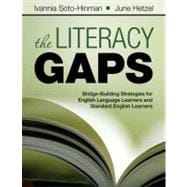
Note: Supplemental materials are not guaranteed with Rental or Used book purchases.
Purchase Benefits
What is included with this book?
| Acknowledgments | |
| About the Authors | |
| Introduction to the Achievement Gap and the "Literacy Gaps Model" | |
| Demographic Patterns | |
| Language Spoken and Socioeconomic Factors | |
| ELL Achievement | |
| Standard English Learners | |
| The National Literacy Panel | |
| The Literacy Gaps Model | |
| Overview of Book Chapters | |
| Summary | |
| Decoding: Word Recognition Strategies and Fluency | |
| Introduction | |
| The Gap Between the Student and the Text | |
| Decoding and Readability of Text | |
| Decoding | |
| English Language Development | |
| Background Knowledge | |
| Summary | |
| Background Knowledge and Experiences | |
| Schema Fit: Becoming a Text Participant | |
| Context: Becoming a Text User (Active Participant) | |
| Linkages: Becoming a Text Analyst (Reading Critically) | |
| Summary | |
| Comprehension | |
| Comprehension Gap | |
| Academic Language | |
| Passage Comprehension | |
| Summary | |
| English Language Development and Academic English | |
| Specialized Language Needs of ELLs | |
| Needs of Standard English Learners | |
| Academic Language Development Lesson Plan | |
| Summary | |
| Perceptions and Expectations | |
| Were Called on Less Frequently and Were Provided Less Time to Respond | |
| Were Given the Answer Rather Than Helped to Solve the Problem Themselves | |
| Were Criticized More Often, and Praised Less | |
| Were Paid Less Positive Attention, but Disciplined More Strictly | |
| Cultural Differences | |
| Connecting the Literacy Domains in Second Language Acquisition | |
| Parental Involvement and the Literacy Domains | |
| Culturally Responsive Teaching | |
| Comprehensive Education | |
| Multidimensional Approaches | |
| Empowerment | |
| Transformative Learning | |
| Emancipatory Education | |
| Summary | |
| Socioeconomic Differences | |
| Implicit and Explicit Codes | |
| Discourse Patterns | |
| Interactional Styles | |
| Written Language Codes | |
| Resource Access | |
| Summary | |
| Language Variables | |
| Academic Language Competence | |
| Summary | |
| Grouping Strategies | |
| Micro Structures That Bridge Language Proficiency Gaps | |
| Macro Structures That Bridge Language Proficiency Gaps | |
| Summary | |
| Beyond the Gap/Envisioning the Future | |
| The Literacy Gaps Model | |
| Summary | |
| Glossary | |
| Index | |
| Table of Contents provided by Ingram. All Rights Reserved. |
The New copy of this book will include any supplemental materials advertised. Please check the title of the book to determine if it should include any access cards, study guides, lab manuals, CDs, etc.
The Used, Rental and eBook copies of this book are not guaranteed to include any supplemental materials. Typically, only the book itself is included. This is true even if the title states it includes any access cards, study guides, lab manuals, CDs, etc.